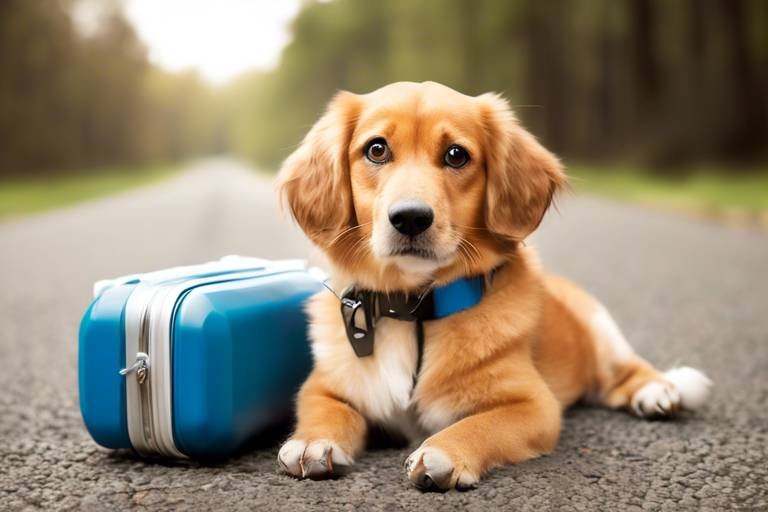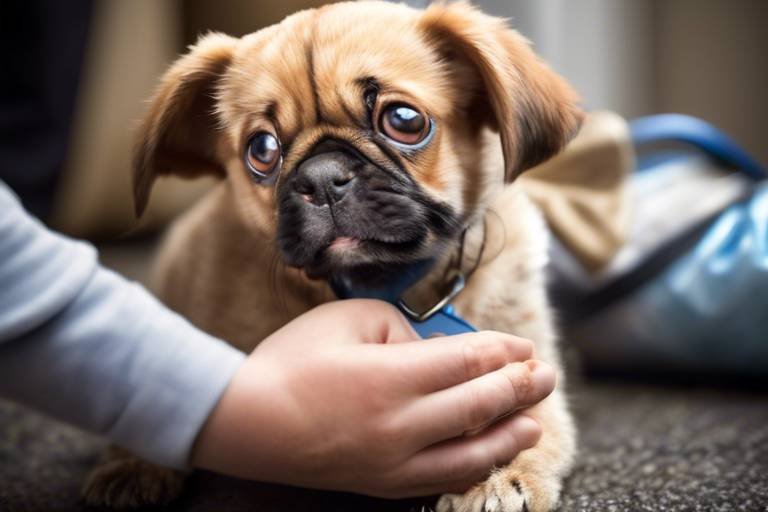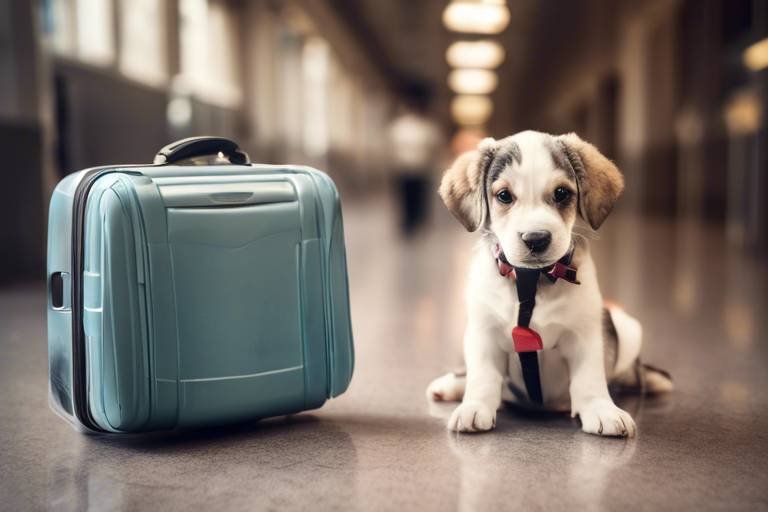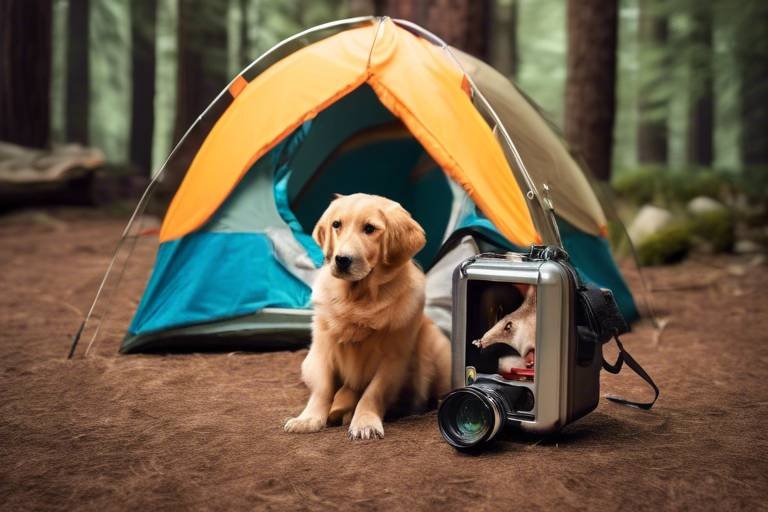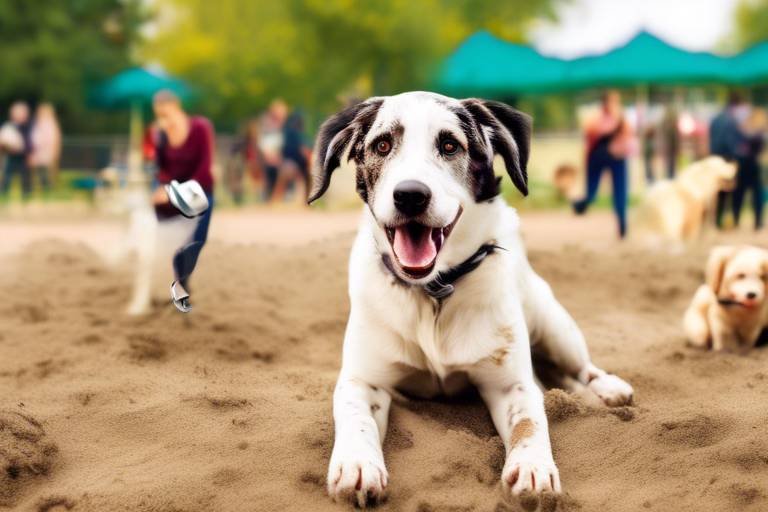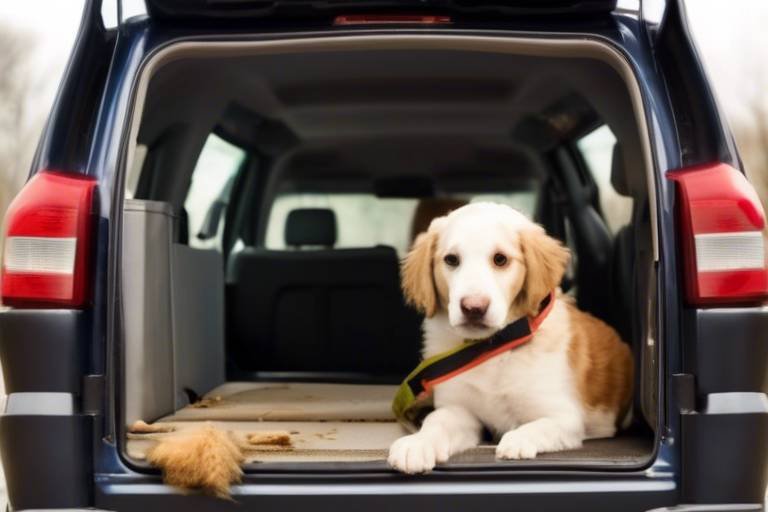How to Prepare Your Pet for an Unexpected Move
Moving can be a whirlwind of chaos, excitement, and sometimes a little bit of panic, especially when you throw your furry friends into the mix. It's not just about packing boxes and loading up the truck; it’s about ensuring that your beloved pets feel safe and secure during this significant transition. After all, they don’t understand why their world is suddenly upside down! So, how can you make this unexpected move a smooth experience for your pets? In this article, we will explore essential tips and strategies that will help minimize stress for both you and your furry companions.
Before diving into the logistics of moving, it’s crucial to take a moment and consider your pet's emotional and physical needs. Just like humans, pets can experience anxiety and confusion during significant life changes. Start by observing your pet’s behavior—are they acting more clingy than usual? Are they hiding? These signs can indicate stress. It’s important to create a safe space for them during the moving process.
To prepare your pet, consider the following:
- Routine: Try to maintain their daily routine as much as possible. Consistency can provide comfort amid the chaos.
- Familiar Items: Keep their favorite toys, blankets, and bedding accessible. Familiar smells can be soothing.
- Calm Environment: If possible, designate a quiet room for your pet during the hectic packing days. This can be their sanctuary away from the noise.
A well-structured moving plan can significantly reduce chaos and ensure that your pet’s needs are met. Start by outlining the steps you need to take, including key considerations for your pet's care and transportation. This plan can be a lifesaver, especially when you’re juggling so many tasks at once.
Here’s a simple structure you can follow:
- Assess your pet’s needs and preferences.
- Choose the right transport method for the move.
- Prepare a pet-friendly packing strategy.
- Establish a timeline for moving day.
Selecting the appropriate transport method for your pet is vital for their comfort and safety. Depending on the distance of your move, you may have several options. Here’s a quick overview:
| Transport Method | Considerations |
|---|---|
| Car | Ensure proper restraint and comfort items are available. |
| Air Travel | Check airline regulations and prepare for security checks. |
| Pet Transport Services | Consider professional services for long-distance moves. |
If you’re hitting the road, there are specific preparations you should consider for a safe and comfortable journey. First, ensure your pet is securely restrained in the car—using a pet seatbelt or a travel crate can prevent distractions and keep them safe. It’s also a good idea to take regular breaks during the drive, allowing your pet to stretch their legs and relieve themselves. Remember to keep their favorite toys or treats handy to help ease any anxiety they might feel during the trip.
Flying with pets can be a bit more complicated, but with the right preparation, it can go smoothly. First, check the regulations of the airline you’ll be flying with, as each has different rules regarding pet travel. Make sure to book a direct flight if possible to minimize stress. Additionally, invest in a comfortable and safe carrier that meets airline standards. You’ll want to acclimate your pet to the carrier before the trip, so they feel more at ease when it’s time to travel.
Acclimating your pet to the moving process can significantly help reduce their anxiety. Start by gradually introducing them to packing materials like boxes and tape. Allow them to explore their environment as you pack, so they become familiar with the changes. You might even consider taking them for short car rides to desensitize them to the idea of travel. The goal is to make the moving process feel as normal as possible for them.
Once the move is complete, it’s essential to help your pet adjust to their new surroundings. Start by creating a welcoming space for them—set up their bed, toys, and feeding area as soon as you arrive. This familiar space can help them feel secure in their new home.
Maintaining a consistent routine can ease the transition for your pets. Establish a new daily routine that includes feeding, walking, and playtime. This structure will provide a sense of normalcy and security for your furry friend as they navigate their new environment. Remember, pets thrive on routine, so keeping things predictable can be incredibly comforting.
Introducing your pet to their new home requires careful consideration. Start by allowing them to explore one room at a time, gradually introducing them to different areas of the house. This can help prevent overwhelming them with too much new information at once. Keep a close eye on their behavior and be patient as they adjust to their new surroundings.
Q: How can I help my pet adjust to the new home?
A: Establish a routine, create a comfortable space, and introduce them gradually to different areas of the house.
Q: Should I use a pet transport service for long-distance moves?
A: If you’re moving a long distance and are concerned about your pet’s safety, using a professional pet transport service can reduce stress for both you and your pet.
Q: What should I do if my pet shows signs of anxiety during the move?
A: Provide a safe space, maintain their routine, and consider using calming products like pheromone diffusers or anxiety wraps.

Understanding Your Pet's Needs
Moving can be a whirlwind of chaos, and amidst all the packing boxes and bubble wrap, it's easy to overlook the emotional and physical needs of our furry companions. Just like us, pets experience stress during transitions, and understanding their unique needs is crucial for a smooth move. Imagine how disoriented you would feel if you were suddenly uprooted from your home without any warning—your pet feels the same way!
First and foremost, take a moment to assess your pet's personality. Is your dog an adventurous explorer or a timid wallflower? Cats can be particularly sensitive to changes in their environment, so knowing whether your pet thrives on routine or is more adaptable will help you tailor your approach. For instance, a more anxious pet may require extra reassurance and a slower introduction to their new surroundings. You can create a safe space in your current home, filled with their favorite toys and blankets, to help them feel secure before the move.
Next, consider their physical needs. Make sure to keep their essentials—food, water, medications, and comfort items—readily accessible. It's wise to pack a special "pet essentials" bag to ensure you have everything on hand during the move. This bag should include:
- Food and Water: Enough for at least a few days.
- Medications: Any prescriptions your pet may need.
- Comfort Items: Their favorite blanket or toy.
- Leash and Carrier: For secure transport.
Moreover, schedule a visit to the vet before the move. This is especially important if you're relocating far away or to a new state. Your vet can provide health records and any necessary vaccinations, which may be required by your new location or boarding facilities. Additionally, they can offer advice tailored to your pet's specific needs during stressful times.
Lastly, don't forget to consider your pet's social needs. If they have a favorite playmate or a routine with other pets, try to maintain those connections as much as possible, even after the move. This familiarity can provide comfort and help ease the transition. Remember, your pet relies on you to provide stability and reassurance during this uncertain time, so keep their needs at the forefront of your moving plan.

Creating a Moving Plan
Moving can feel like a whirlwind, can't it? One moment you're enjoying your cozy home, and the next, you're surrounded by boxes and packing tape. But don’t worry! Creating a solid moving plan can help you regain control and make the process smoother, especially for your furry companions. Start by outlining the key elements of your move, and make sure your pets are at the forefront of your planning. After all, they rely on you to keep them safe and comfortable during this transition.
First things first, consider the timeline of your move. When will you be moving? Having a clear date in mind allows you to break down tasks into manageable chunks. For instance, you might want to start by creating a checklist that includes everything from finding a new home to ensuring your pet's medical records are ready for the new vet. Here’s a quick overview of what your checklist might look like:
| Task | Deadline | Status |
|---|---|---|
| Find a new home | 2 months before | Pending |
| Book a moving company | 1 month before | Pending |
| Update pet's microchip info | 2 weeks before | Pending |
| Pack pet's essentials | 1 week before | Pending |
In addition to the timeline, you should also think about your pet's specific needs during the move. This includes their food, medications, and comfort items. Make sure to pack a special bag for your pet that includes their favorite toys, bedding, and enough food and water for the journey. This way, they have familiar items to cling to amidst the chaos. You might even consider creating a Pet Moving Kit that includes:
- Food and water bowls
- Enough food for several days
- Leash and harness
- Medications and health records
- Comfort items like toys or blankets
Also, don’t forget to think about your pet’s transportation. Will you be driving, or are you flying to your new destination? Each option comes with its own set of considerations and preparations. For example, if you're driving, you need to ensure your pet is secure and comfortable during the journey. If you're flying, check the airline’s regulations regarding pet travel well in advance. This will help you avoid any last-minute surprises!
Lastly, remember that a little bit of flexibility goes a long way. Moving can be unpredictable, and things may not always go according to plan. Keeping a positive attitude and being ready to adapt can help you manage any hiccups along the way. After all, your pets will pick up on your energy, so staying calm and collected will also help them feel more secure during the transition.
Choosing the Right Transport
When it comes to moving, one of the most critical decisions you'll face is how to transport your furry friend. The right transport method can make all the difference in ensuring your pet's comfort and safety during the journey. Whether you're hitting the road or taking to the skies, understanding your options is key. So, let’s dive into the various transport methods and what you should consider for each.
First off, think about the distance you’re traveling. If it's a short trip, driving might be the most convenient option. However, for long distances or international moves, you might need to consider air travel. Each method has its pros and cons, and your pet's needs should be at the forefront of your decision-making process.
For car travel, you’ll want to ensure that your pet is secure. This means investing in a good quality pet seatbelt or a travel crate that meets safety standards. Not only does this keep your pet safe, but it also minimizes distractions while you’re driving. Remember, a calm pet makes for a smoother ride. Make sure to take regular breaks during long drives to allow your pet to stretch, hydrate, and relieve themselves.
On the other hand, if you’re considering air travel, be prepared for a bit more planning. Airlines have specific regulations regarding pet travel, which can vary significantly. Researching the airline's pet policy is essential to avoid any last-minute surprises. Some airlines allow pets in the cabin, while others may require them to travel in the cargo hold. Make sure to check the size and weight restrictions for in-cabin travel, as well as any necessary health certificates or vaccinations.
If you decide to travel by air, consider booking a direct flight to minimize the stress of layovers. Additionally, familiarize your pet with their travel crate well in advance. You can do this by allowing them to explore the crate at home, making it a cozy space with their favorite blanket or toy. This will help your pet associate the crate with positive experiences, reducing anxiety during the actual travel.
In summary, choosing the right transport method for your pet involves careful consideration of their needs, the distance of the move, and the specific regulations of your chosen transport. Whether you're driving or flying, ensuring your pet's comfort and safety should always be your top priority. After all, a happy pet leads to a happy move!
Car Travel Tips
Traveling by car with your pet can be an adventure filled with excitement and bonding moments, but it also comes with its own set of challenges. To ensure a smooth journey, you need to prepare adequately and keep your furry friend’s comfort and safety in mind. First and foremost, it's essential to secure your pet in the vehicle. Using a pet seatbelt or a well-ventilated carrier can prevent distractions and protect your pet in case of sudden stops. Think of it like buckling up your child; it’s all about safety!
Before hitting the road, take some time to familiarize your pet with the car. If possible, let them explore the vehicle while it’s parked. This will help them associate the car with positive experiences rather than just a means of transport. You might even consider taking short practice trips around the neighborhood to get them used to the sensation of moving. Just like we need to stretch before a workout, pets benefit from a little warm-up too!
Another critical aspect of car travel is planning for breaks. Just like humans, pets need to stretch their legs and relieve themselves during long journeys. Aim to stop every couple of hours to let your pet walk around, hydrate, and sniff out new scents. This not only helps them burn off some energy but also reduces anxiety. If you're traveling with a dog, consider this a mini-adventure for them—each stop is a chance to explore!
Don’t forget to pack a travel kit for your pet. This should include their favorite toys, a blanket to make them feel at home, food, water, and any necessary medications. Having familiar items can ease anxiety and make your pet feel secure. You wouldn’t go on a trip without your essentials, right? The same goes for your furry companion.
Lastly, keep in mind the temperature inside the car. Never leave your pet alone in a parked car, especially on hot days, as it can lead to heatstroke in a matter of minutes. Instead, consider using sunshades on the windows or keeping the air conditioning running if your pet is traveling with you. Think of it as creating a little oasis for them while you’re on the road!
Air Travel Considerations
Flying with your furry friend can be an adventure, but it also comes with its own set of challenges and considerations. First and foremost, it's crucial to check the airline's specific pet travel policies well in advance of your departure. Each airline has different rules regarding pet transport, including size restrictions, carrier requirements, and fees. Make sure you’re well-informed to avoid any last-minute surprises.
When preparing for air travel, consider your pet’s comfort as a top priority. The travel carrier should be well-ventilated, secure, and spacious enough for your pet to stand, turn around, and lie down comfortably. It's a good idea to familiarize your pet with the carrier beforehand; let them explore it at home, so it doesn’t feel like a foreign prison when it’s time to board the plane. You can place their favorite blanket or toy inside, creating a sense of familiarity and comfort.
Another critical aspect to consider is your pet's health. Schedule a visit to the vet to ensure your pet is fit for travel. Some airlines may require a health certificate issued by a veterinarian within a certain timeframe before travel. Additionally, discuss any medications your pet may need during the journey, especially if they tend to get anxious or motion sick.
It's also worth noting that air travel can be stressful for pets. To ease their anxiety, you might want to consider using calming products such as pheromone sprays or anxiety wraps. However, consult your veterinarian before administering any medication, as they can provide tailored advice based on your pet's health and temperament.
Lastly, keep your pet's essentials handy. Pack a small bag with food, water, a collapsible bowl, and any necessary medications. This way, you can easily access what your pet needs during layovers or delays. Remember, preparation is key to ensuring your pet has a safe and smooth flying experience. By taking these precautions, you can help your pet navigate this new and potentially overwhelming environment with ease.
- What should I do if my pet is anxious about flying?
Consider using calming aids like pheromone sprays or consult your vet for medication options. Familiarizing your pet with the carrier before the trip can also help.
- Are there any breed restrictions for air travel?
Yes, some airlines have restrictions on brachycephalic breeds (like Bulldogs or Persians) due to their increased risk of breathing issues in stressful situations.
- Can I take my pet in the cabin with me?
Many airlines allow small pets to travel in the cabin if they fit in an approved carrier under the seat. Always check the specific airline's policy.
Preparing Your Pet for the Move
When it comes to moving, pets can often feel like they’re caught in the whirlwind of chaos. It’s essential to remember that they thrive on routine and familiarity, which can be disrupted during such a significant change. To help your furry friends adjust, you’ll want to start preparing them well before the moving day arrives. Think of this process as a gentle introduction to a new adventure rather than a sudden upheaval. Just like you wouldn’t jump into a cold pool without easing in first, your pet needs a similar approach.
One of the first steps in preparing your pet is to familiarize them with packing materials. As you start to pack boxes and bubble wrap, let your pet explore these new items. This can help alleviate any anxiety they might feel about the strange objects taking over their space. You can even create a designated area with their favorite toys and blankets to keep them comfortable amidst the chaos. Imagine how disorienting it would be for them to see their environment changing without any warning!
Another crucial aspect is to maintain their routine as much as possible. Try to stick to their regular feeding, walking, and playtime schedules. This consistency will provide a sense of security for your pet, making the transition smoother. You might also want to consider using calming products, such as pheromone diffusers or anxiety wraps, which can be particularly beneficial in reducing stress levels during this time. You wouldn’t want to throw your pet into a new situation without a safety net, right?
As the moving day approaches, it’s wise to introduce your pet to their travel carrier or crate. Whether it’s a short car ride or a long-distance move, getting them comfortable with their travel space is essential. You can make the carrier feel like a safe haven by placing familiar blankets or toys inside. Allow them to explore it on their own terms, and perhaps even feed them treats inside to create positive associations. This way, when it’s time to hit the road, they won’t see it as a punishment but rather as a cozy retreat.
Finally, don’t forget to schedule a vet visit before the move. Ensure that your pet is up-to-date on vaccinations and obtain any necessary health certificates, especially if you’re traveling long distances or flying. It’s also a good opportunity to discuss any concerns you may have about your pet’s behavior during the move. Your vet can provide valuable tips and may recommend calming medications if your pet tends to get particularly anxious.
In summary, preparing your pet for a move is all about creating a sense of safety and familiarity. By gradually introducing them to packing materials, maintaining their routine, making travel arrangements comfortable, and consulting with a vet, you’re setting the stage for a smoother transition. Remember, your pet looks to you for guidance, so stay calm and positive, and they will likely follow your lead!

Settling into the New Home
Once the moving truck has pulled away and the dust has settled, it’s time to turn your attention to one of the most important aspects of your move: helping your pet feel at home in their new environment. Just like us, pets can experience a whirlwind of emotions during a move, from excitement to anxiety. So, how can you make this transition smoother for your furry friend? The key lies in creating a welcoming atmosphere that fosters comfort and security.
First and foremost, designate a safe space for your pet in your new home. This could be a cozy corner of a room or a separate area where they can retreat if they feel overwhelmed. Fill this space with their favorite blanket, toys, and perhaps a piece of your clothing to provide a sense of familiarity. By establishing this sanctuary, you give your pet a personal refuge amidst the chaos of unpacking and settling in.
Next, it’s essential to maintain some level of consistency in their routine. Pets thrive on predictability, so try to keep feeding times, walks, and play sessions as close to their previous schedule as possible. This consistency can help mitigate the stress of the move, allowing them to adjust more quickly to their new surroundings. For instance, if your dog was used to a morning walk at 7 AM, aim to stick to that routine even in your new neighborhood.
As you begin to explore your new home, take the time to introduce your pet to different areas gradually. Start with one room at a time, allowing them to sniff around and explore at their own pace. This gradual introduction can help prevent overwhelming them with too many new smells and sights all at once. As they become more comfortable, you can encourage them to venture into other parts of the house. Remember, patience is key! Just like you, they need time to adjust to their new digs.
Additionally, consider setting up a playtime schedule that incorporates some of your pet’s favorite activities. Engaging in play not only helps to alleviate anxiety but also strengthens the bond between you and your pet. Whether it’s a game of fetch in the backyard or a tug-of-war session in the living room, these moments of fun can be a great distraction from the stress of moving.
Finally, don’t forget to explore the neighborhood together! Once your pet has settled into the house, take them for walks around the area. This not only allows them to familiarize themselves with their new environment but also gives them the chance to meet other pets and people. Just like you, they’ll want to know where the best parks are and who their new friends might be!
To further assist you in this transition, let’s address some common questions pet owners have when moving:
- How long does it take for pets to adjust to a new home? Every pet is different, but it can take anywhere from a few days to a few weeks for them to feel fully comfortable in their new surroundings.
- Should I keep my pet confined to one room during the move? It’s best to keep your pet in a quiet, safe room during the chaos of moving day, but once the move is complete, allow them to explore gradually.
- What should I do if my pet shows signs of stress? If your pet seems anxious or stressed, provide them with their favorite toys, spend extra time with them, and maintain a calm demeanor to help soothe their nerves.
Establishing a Routine
After the dust has settled from your move, one of the most important things you can do for your pet is to establish a routine. Just like humans, pets thrive on consistency and predictability. Imagine how disorienting it must be for your furry friend to suddenly find themselves in a new environment with unfamiliar sounds and smells. By creating a daily schedule, you can help ease their anxiety and make the transition smoother.
Start by setting regular times for feeding, walks, and play sessions. For instance, if your dog is used to being fed at 7 AM, try to stick to that time as closely as possible. This not only helps your pet feel secure but also reinforces the idea that some things remain the same, even in a new place. A simple daily routine could look something like this:
| Time | Activity |
|---|---|
| 7:00 AM | Feeding |
| 8:00 AM | Morning Walk |
| 10:00 AM | Playtime |
| 12:00 PM | Afternoon Nap |
| 5:00 PM | Evening Walk |
| 6:00 PM | Feeding |
| 8:00 PM | Calm Play/Relaxation |
In addition to the daily schedule, it’s essential to introduce your pet to their new environment gradually. Start by allowing them to explore one room at a time. This controlled exposure can help them feel less overwhelmed. You might notice your pet is curious about their new space, sniffing around and checking things out. Encourage this exploration by following them and providing positive reinforcement—maybe a treat or a gentle pat when they show interest in their new surroundings.
Another key aspect of establishing a routine is incorporating familiar items into your pet's new space. Bring along their favorite toys, blankets, or beds. The familiar scents can provide comfort and a sense of security. Just like how a child might cling to a beloved stuffed animal in a new place, your pet will appreciate these little pieces of home.
Finally, don’t forget to give your pet plenty of attention during this transition. Spend time playing, cuddling, or simply being near them. This will help reinforce the bond you share and reassure them that they are safe and loved in their new home. Remember, the goal is to create a safe haven for your pet where they can relax and feel at ease. By establishing a routine, you not only help your pet adjust but also make the moving experience less stressful for yourself.
- How long will it take for my pet to adjust to the new home? Every pet is different, but it can take anywhere from a few days to several weeks for them to fully acclimate.
- What if my pet seems anxious in the new environment? Try to create a safe space for them with familiar items and give them time to explore at their own pace.
- Should I change my pet's routine after moving? It's best to keep their routine as consistent as possible to help them feel secure.
Introducing Your Pet to the New Environment
Moving to a new home can be a whirlwind of excitement and chaos, but for your furry friend, it can also be a source of anxiety. The unfamiliar sights, sounds, and smells can overwhelm them, making it essential to introduce your pet to their new environment with care and patience. Just like we need time to adjust to new surroundings, our pets do too! So, how can you ensure that your pet feels comfortable and secure in their new home? Let’s dive into some effective strategies.
First and foremost, designate a safe space for your pet as soon as you arrive at your new home. This can be a quiet room or a cozy corner filled with their favorite blanket, toys, and perhaps a piece of your clothing. This familiar space acts as a sanctuary, allowing your pet to retreat and feel safe while they acclimate to the new environment. You wouldn’t want to be thrown into a bustling party without a place to catch your breath, right? Your pet feels the same way!
Next, it's crucial to introduce your pet to the new home gradually. Start by allowing them to explore one room at a time. You can accompany them, offering gentle encouragement and praise as they venture into new spaces. This method not only helps them familiarize themselves with their surroundings but also builds their confidence. Remember, patience is key here; if your pet seems hesitant, don’t rush them. Allow them to take their time and explore at their own pace.
While your pet is exploring, pay attention to their reactions. Are they curious, or do they seem anxious? If they appear stressed, consider using calming products like pheromone diffusers or sprays, which can help soothe their nerves. You might also want to keep their routine as consistent as possible during this transition. Familiar feeding times, walks, and play sessions can provide a sense of normalcy amidst the change.
As your pet becomes more comfortable, introduce them to different areas of the house. You can create a simple plan to guide this process, like so:
| Area | Introduction Strategy |
|---|---|
| Living Room | Allow them to sniff around while you sit nearby, engaging them with toys. |
| Kitchen | Show them where their food and water bowls will be; let them explore while you prepare their meals. |
| Bedrooms | Introduce them to your bedroom first, then gradually to other rooms, ensuring they feel secure. |
| Outside | Once they are comfortable indoors, take them outside to explore the yard or nearby park. |
Lastly, don’t forget to give your pet plenty of love and attention during this time. Positive reinforcement can go a long way in helping them adjust. Treats, belly rubs, and playtime can create positive associations with the new environment. Your pet will pick up on your energy, so stay relaxed and upbeat. After all, you are their anchor in this new adventure!
In conclusion, introducing your pet to a new environment doesn’t have to be a daunting task. With a little bit of planning, patience, and love, you can help them transition smoothly and feel right at home in no time. Remember, every pet is unique, so tailor your approach to fit their personality and needs. Happy moving!
- How long does it take for pets to adjust to a new home? - It varies by pet, but most will take a few days to a few weeks to fully acclimate.
- What should I do if my pet is anxious during the move? - Keep their routine consistent, provide a safe space, and consider calming products.
- Can I let my pet roam freely in the new house immediately? - It's best to introduce them to one room at a time to avoid overwhelming them.
Frequently Asked Questions
- How can I assess my pet's needs during a move?
It's essential to observe your pet's behavior and mood during this stressful time. Look for signs of anxiety, such as excessive barking, hiding, or changes in appetite. Providing a consistent environment and familiar items, like their favorite toys or blankets, can help ease their discomfort.
- What should I include in my moving plan for my pet?
Your moving plan should outline your pet's care, including their feeding schedule, transportation methods, and any necessary vet visits. Make sure to allocate time for breaks during travel and have a checklist of items to pack for your pet, such as food, water, medications, and comfort items.
- What are the best transport options for my pet?
The best transport option depends on your pet's size, temperament, and the distance of the move. For short distances, a car may be ideal, while air travel might be necessary for longer distances. Always ensure your pet is secured in a comfortable carrier or seatbelt designed for pets.
- How can I prepare my pet for car travel?
Before the trip, take your pet on short car rides to help them acclimate. Ensure they are safely secured in a pet seatbelt or carrier. Bring along their favorite toys and plenty of water. Remember to take regular breaks for bathroom and stretching needs!
- What should I consider when flying with my pet?
When flying, check the airline's specific pet policies and book a pet-friendly flight. Ensure your pet's carrier meets size requirements and is well-ventilated. It’s also a good idea to consult with your vet about any health concerns related to air travel.
- How can I help my pet adjust to the new home?
Creating a quiet, comfortable space for your pet in the new home is crucial. Use familiar items to help them feel secure. Gradually introduce them to different areas of the house, allowing them to explore at their own pace. Establishing a routine can also help them settle in more quickly.
- What routine should I establish for my pet in the new home?
Try to maintain the same feeding, walking, and playtime schedule as before. Consistency is key! This helps your pet feel more secure and understand that their new home is a safe space. Gradually adapt the routine as they become more comfortable in their new surroundings.
- How do I introduce my pet to different areas of the new house?
Start by allowing your pet to explore one room at a time. Use treats and positive reinforcement to encourage them. Keep an eye on their body language—if they seem overwhelmed, give them time to adjust before moving on to the next area.




